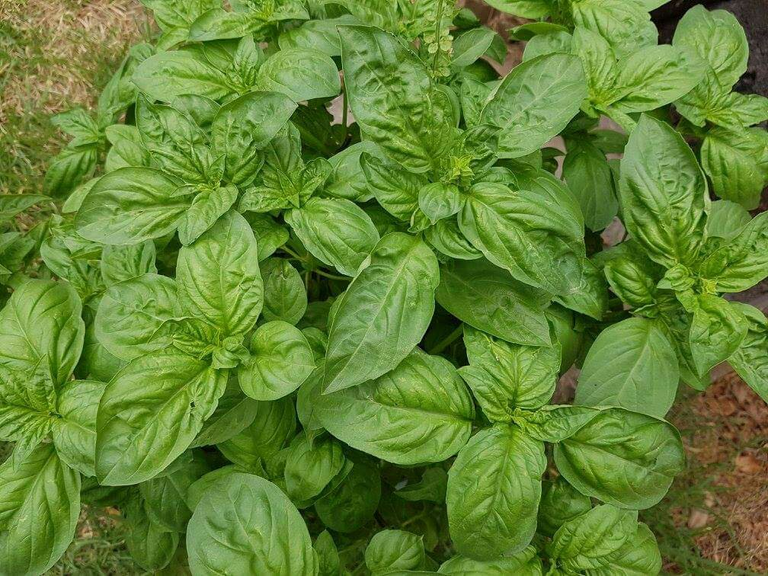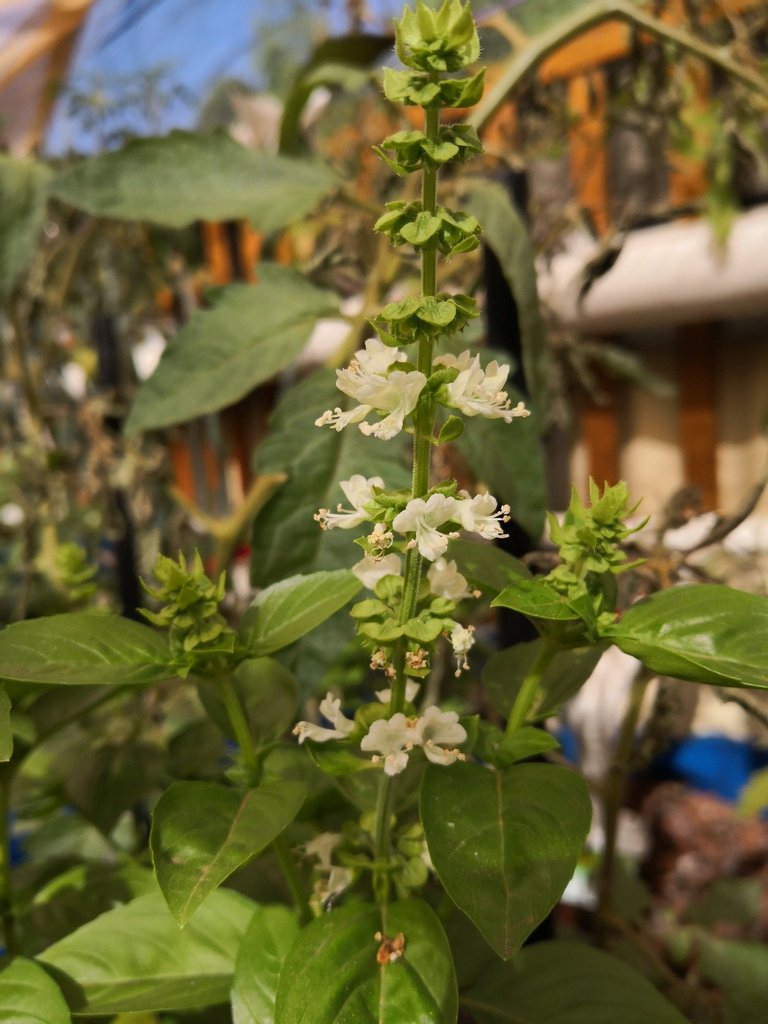Common names: Basil, Sweet Basil, The Queen of Herbs, Babuitulsi, Tulsi, Luo Le,
Taxonomic name: Ocimum basilicum (Common Basil), Ocimum sanctum or O.tenuiflorum (Holy Basil)
Family: Lamiaceae
Related herbs: Oregano, Marjoram, Mint
Area of origin: Central Africa, South East Asia
Parts used: leaves, stems, flowers, seed
Can be used for: antipyretic, detoxification, colds and flu, blood pressure issues, melancholy. fatigue, stress, tension, digestive issues, allergies, resolvent, poor menstruation, expelling afterbirth, poor appetite, nausea, headaches, gum infections, cramps, inflammation
Organ/System affinities: Lung, Heart, Spleen, Stomach
Healing Actions: diaphoretic, hepatic, emmenagogue, lactagogue, diuretic, sedative, nervine, antispasmodic, analgesic, antimicrobial, disinfectant, carminative, adrenal tonic, adaptogen
Taste: herb – pungent, bitter seed – pungent, sweet
Tissue states: depression, torpor, wind
Energetics: herb – dispersing,drying, seed – cooling, moistening
Healing constituents: Aromatic oil (estragole), camphor, butterine, flavonoids, polyphenolic acids, triterpenes, vitamins A&C
Warnings: Both Basils can are emmenagogues so be careful using them during pregnancy. Basil has been traditionally used to expel the afterbirth.
I've been blogging a lot of late about our Ligaya Garden herbs. These are all herbs that we grow their for their food and medicinal properties. They're easy to grow and simple to make remedies from. We are based in South Australia but these herbs are pretty easy to find everywhere in the world. I'd like to thank @diyhub, @hivepakistan,and @nikv, @jotakrevs, @ewkaw from @curangel for reblogging and promoting these posts so often.Id also like to acknowledge the other communities that I post and crosspost them in - @naturalmedicine, @hivegarden, @ecotrain, @homesteading, @proofofbrain, @stemsocial, @silverbloggers. The more we can get herbal remedies out there, the easier it will be to look after some of our own health in these increasingly difficult times. If you feel the urge, please reblog these posts wherever you see fit.
Description
Basil needs little introduction, especially as were just coming out of a long Summer where I’m sure it was paired with tomatoes in lots of your kitchens. I’ll call the European Basil, ‘Basil’ and sacred Basil from Asia, one ‘Tulsi’ for convenience.
Basil is an upright annual that some folks reckon can reach a metre in height. I’ve not seen ours get that tall – maybe because we use it all the time and keep it trimmed. It has the square stem of the Mint Family. Two lipped, white flowers grow in whorls on terminal spikes. To keep your Basil compact and bushy, keep cutting the stems. Every time you cut one, it forms more branches which means more leaves – more Basil! Tulsi is pretty similar but has purple flowers.

Basil leaves are soft and either green or purple and are slightly toothed. Tulsi leaves tend to be smaller here and have distinctively toothed margins.
Tulsi is a perennial in most areas but is hard hit by frost and may not make it to the next year. Basil is an annual.
Medicinal use
Some purists separate Basil and Tulsi in their lists and there are reasons for that but until I become a world class herbalist with a bit of paper to prove it, I’ll just combine them both here. The only difference of note at this stage is that in Ayurveda and TCM, Tulsi seeds are used for their cooling, moistening properties.
Basil (Ocimum basilicum) is a spicy, warm herb. As with many that share those characteristics, Basil is stimulating to our system. A little later we’ll look at its cooling and relaxing property too.
Basil is my favourite herb for ‘cleaning house’ when one has a cold or the flu. Its capacity to warm, stimulate and disperse fluids makes it a good one to reach for when you’re feeling just plain yucky when you’re ill. Basil’s taste is uplifting and freshening and it affects many systems, helping them clean themselves out. It’s so good at stimulating cleaning that it is used for detoxing from drug use (especially Cannabis) and cleaning heavy metals from your body. Basil frees chemicals, metals and medicinal drugs that are held or stored in fat cells.
It detoxifies through making us sweat (diaphoresis, if you want to be technical). This property alone can guide us to many of its uses. It opens the pores in the skin and the lungs, and moves fluids to the outside, allowing toxins to leave our body through sweat and breath. Basil also works deeply inside, detoxifying the liver and through this, the blood. It supports the kidneys and promotes urination. One of the interesting things about Basil if you look into some herbal sources, is that it is listed as a ‘resolvent’. This is a property that some herbs have that helps move the deposits that arise from inflammation into the lymphatic and other excretory channels. A herb like Basil is doubly good – it cleans deeply, then encourages paths of elimination.
You may have noticed, if you’ve read other pages on this website, that lots of herbs in the Mint family (Lamiaceae) are cleaners. They cleanse and detoxify either the whole, or specific parts of our bodies, working by the actions of an essential oil.
One other way that Basil cleans can be gained through its seeds. When soaked, the seeds swell to a gelatinous mass with a hard centre. Not only is this nutritious, but is a good source of fibre that can both feed gut microbes, add bulk to stools and generally give your insides a polish.
Basil can be used for lowering blood pressure because of its ability to move fluids. It doesn’t lower blood pressure through a diuretic (urinary) action, it moves fluids out through the skin (diaphoretic).
Basil’s warming nature soothes the stomach and eases digestion through the actions of its aromatic oil. Its dispersing, warming nature makes it great for headaches that come from or are made worse by the cold, especially those horrid congestive headaches that attend a serious bout of the flu.

As a nervine, Basil is amphoteric – it can normalise (either stimulate or relax as required) the nervous system. If we are too tense, Basil can relax us or if we’re too relaxed (is that possible?) Basil can stimulate us. Herbalist Matthew Wood mentions that in the Middle East, Basil is used to go to sleep AND to make the user more alert upon waking.
Basil is also known as an antibacterial primarily through topical application and it does have benefits for sufferers of bad breath.
Preparing and using Basil
Basil is a must to have dried in the kitchen and fresh in the garden. It is such a powerful herb that it only needs to be included regularly in cooking to share its effects. I make a Basil tea or infusion from time to time to warm me in Winter or cool me in Summer.
Chewing fresh Basil leaves can clear bad tastes from the mouth, improve the flow of saliva and help with gum infections. Crushing the leaves and inhaling the scent can help with congestive and cold type headaches. Crushing leaves and rubbing them on the temples can alleviate them too, especially at their first sign.
Because of its aromatic properties, Basil is best tinctured in alcohol that is greater than 60% I don’t tincture Basil very often as I’ve found that for our purposes strong Basil tea does the job.
Tulsi makes a pretty good glycerite.
Basil seed can be soaked until they swell and become gelatinous. This is a great source of fibre and can be eaten or mixed with drinks.
If you look back over this blog, you can see heaps of info on the topic, plus loads and loads of posts on herbs and using Australian bushfoods from a white perspective. If you haven't been around on in the @hivegarden and @naturalmedicine communities for long, you may be interested in looking back. There's w-a-a-a-a-y too much there for me to repost and the Hive system doesn't let you vote on old posts so, if you're happy with what you find, I believe that there is now a tip option...





